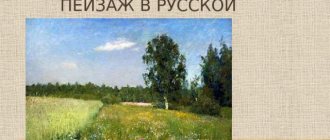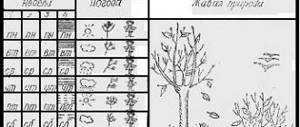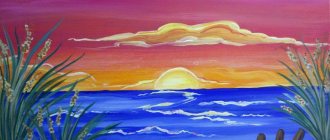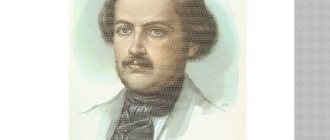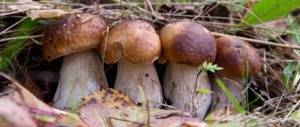Presentation “Landscape in Literature, Music and Painting” - student work.
Slide 1
Landscape in music, literature and painting COMPLETED: 8th grade student Mikhailechko Svetlana with 10th grade student Irina Shapovalova Supervisor Stepanenko Raisa Nikolaevna
Slide 2
Chapter 1. LANDSCAPE IN MUSIC
Slide 3
The theme of nature has long attracted musicians. Nature gave music sounds and timbres that were heard in the singing of birds, in the murmur of streams, in the noise of a thunderstorm. Sound-imagery as an imitation of the sounds of nature can be found already in the music of the 15th century. Landscape in music...
Slide 4
Thus, the path was laid out for music to master its landscape and visual capabilities. Among the bright musical paintings associated with the image of nature is the cycle of P.I. Tchaikovsky "Seasons". Each of the twelve plays in the cycle represents an image of one of the months of the year, and this image is most often conveyed through the landscape. Landscape in music...
Slide 5
The landscape in music can be likened to the landscape in works of painting - so varied are the pictures of nature that composers turned to. Not only the seasons, but also the times of day, rain and snow, forest and sea elements, meadows and fields, earth and sky - everything finds its sound expression, sometimes literally striking in its visual precision and power of impact on the listener. LANDSCAPE IN MUSIC…
Slide 6
The creation of many landscape images belongs to impressionist composers. In their work, themes requiring special musical visualization, including themes of a landscape nature, were widely developed. Impressionism (from the French impression - impression) is an artistic movement that developed in Western Europe in the last quarter of the 19th and early 20th centuries. Landscape in music...
Slide 7
The musical landscape of the impressionists is an area of detailed development of all means of expression that give the sound color, visibility, and picturesqueness. Picturesqueness is already present in the titles of the works: for example, “Sails”, “Wind on the Plain”, “Moonlight”, “Steps in the Snow”, “Mists” (these are all the names of preludes by the French impressionist composer Claude Debussy), as well as “The Game” water", "Reflections" (piano pieces by Maurice Ravel), "Nights in the Gardens of Spain" by M. de Falla, "Impressions of Nature" (orchestral cycles by D. Malipiero), etc. The music of the Impressionists revealed the ability to convey not only colors, but also highlights and shadows. Such possibilities of music turned out to be consonant with the painting of the Impressionists. Perhaps never before have these two arts been so close to each other. LANDSCAPE IN MUSIC…
Slide 8
Chapter 2. LANDSCAPE IN LITERATURE
Slide 9
Landscape in literature is one of the most powerful means for creating an imaginary, “virtual” world of a work, an essential component of artistic space and time. Landscape in literature
Slide 10
There are almost no works in Russian literature that lack landscape. Writers have sought to include this extra-plot element in their works for a variety of purposes. So, for example, in the story “Poor Liza” by Karamzin, picturesque pictures of nature, at first glance, can be considered random episodes that are just a beautiful background for the main action. But landscapes are one of the main means of revealing the emotional experiences of the characters. In addition, they serve to convey the author’s attitude to what is happening. Landscape in literature...
Slide 11
Thus, landscapes in a work of art help to penetrate deeply into the soul of the characters and their experiences, and to better understand the author’s ideological intent. Landscape in literature...
Slide 12
Chapter 3. LANDSCAPE IN PAINTING
Slide 13
The emergence of landscape painting as a genre of fine art reflects the interest of artists in nature and ways of depicting it. At different periods of its history, fine art performed different functions. Ancient rock paintings had cult significance in the life of prehistoric people. In ancient times, paintings told about the lives of people or the lives of mythological characters. In the Middle Ages, painting served mainly the interests of religion, and in addition, it performed an educational function in a society where most members were illiterate. Until this time, landscape painting practically did not exist; nature could be depicted only conditionally - as a background for scenes from the lives of saints or characters from the Gospel. Landscape in painting…
Slide 14
During the Renaissance, artists began to choose their own subjects for their paintings. Based on the artistic principles of Greco-Roman classicism, a new direction of painting grew, reflecting the natural world. In impressionism and subsequent painting movements, landscape, like no other genre, allowed experimentation - trying out new techniques and color combinations. Landscape in painting...
Slide 15
Thank you for your attention!
Images of nature in music, literature, painting (presentation for a music lesson in 6th grade)
#6th grade #Music #School education #Project activity #Presentation
Images of nature in music, literature, painting Completed by a student of class 6 “A” Kuliyeva Safiyat
What is nature? What is nature? Nature is the material world of the Universe; in essence, it is the main object of study of the natural sciences.
What is music? What is music? Music is an art form. Specially organized sounds serve as a means of conveying mood and feelings in music. The main elements and expressive means of music are: melody, rhythm, meter, tempo, dynamics, timbre, harmony, instrumentation and others. Music is a very good means of nurturing a child’s artistic taste; it can influence mood; in psychiatry there is even special music therapy. With the help of music, you can even influence a person’s health: when a person hears fast music, his pulse quickens, his blood pressure rises, he begins to move and think faster. Music is usually divided into genres and types.
IMAGES OF NATURE IN MUSIC The sounds of nature served as the basis for the creation of many musical works. Nature sounds powerful in music. The ancient people already had music. Primitive people sought to study the sounds of the surrounding world; they helped them navigate, learn about danger, and hunt. Observing objects and natural phenomena, they created the first musical instruments - drum, harp, flute. Musicians have always learned from nature. Even the sounds of the bell, which are heard on church holidays, sound due to the fact that the bell was created in the likeness of a bell flower. Great musicians also learned from nature: Tchaikovsky was not out of the woods when he wrote children’s songs about nature and the “Seasons” cycle. The forest suggested to him the mood and motives of a piece of music.
IMAGES OF NATURE IN LITERATURE AND PAINTING The heritage of Russian literature is great. The works of the classics reflect the characteristic features of the interaction between nature and man inherent in the past era. It is difficult to imagine the poetry of Pushkin, Lermontov, Nekrasov, the novels and stories of Turgenev, Gogol, Tolstoy, Chekhov without describing pictures of Russian nature. The works of these and other authors reveal the diversity of the nature of their native land and help to find in it the beautiful sides of the human soul. Thus, in the works of Ivan Sergeevich Turgenev himself, nature is the soul of Russia. In the works of this writer, the unity of man and the natural world can be traced, be it an animal, a forest, a river or a steppe. Tyutchev’s nature is diverse, multifaceted, full of sounds, colors, and smells. Tyutchev's lyrics are imbued with admiration for the greatness and beauty of nature: I love a thunderstorm in early May, When the first thunder of spring, As if frolicking and playing, Rumbles in the blue sky. Young peals are thundering, the rain is splashing, dust is flying, rain pearls are hanging. And the sun gilds the threads.
Every Russian person is familiar with the name of the poet Sergei Aleksandrovich Yesenin. All his life Yesenin worshiped the nature of his native land. “My lyrics are alive with one great love, love for my homeland. The feeling of homeland is fundamental in my work,” said Yesenin. All people, animals and plants in Yesenin are children of one mother - nature. Man is part of nature, but nature is also endowed with human traits. An example is the poem “Green Hairstyle...”. In it, a person is likened to a birch tree, and she is like a person. It is so interpenetrating that the reader will never know whether the poem is about a tree or a girl. Every Russian person is familiar with the name of the poet Sergei Aleksandrovich Yesenin. All his life Yesenin worshiped the nature of his native land. “My lyrics are alive with one great love, love for my homeland. The feeling of homeland is fundamental in my work,” said Yesenin. All people, animals and plants in Yesenin are children of one mother - nature. Man is part of nature, but nature is also endowed with human traits. An example is the poem “Green Hairstyle...”. In it, a person is likened to a birch tree, and she is like a person. It is so interpenetrating that the reader will never know whether the poem is about a tree or a girl. It’s not for nothing that Mikhail Prishvin is called the “singer of nature.” This master of artistic expression was a subtle connoisseur of nature, perfectly understood and highly appreciated its beauty and riches. In his works, he teaches to love and understand nature, to be responsible to it for its use, and not always wisely. The problem of the relationship between man and nature is illuminated from different angles. This does not cover all the works that touch on the issue of the relationship between man and nature. For writers, nature is not just a habitat, it is a source of kindness and beauty. In their ideas, nature is associated with true humanity (which is inseparable from the consciousness of its connection with nature). It is impossible to stop scientific and technological progress, but it is very important to think about the values of humanity. All writers, as convinced connoisseurs of true beauty, prove that human influence on nature should not be destructive for it, because every meeting with nature is a meeting with beauty, a touch of mystery. Loving nature means not only enjoying it, but also treating it with care.
Images of animals and people made in the era of primitive society on the walls of caves have survived to our times. Many millennia have passed since then, but painting has always remained an invariable companion to a person’s spiritual life. In recent centuries, it is undoubtedly the most popular of all types of fine art. Images of animals and people made in the era of primitive society on the walls of caves have survived to our times. Many millennia have passed since then, but painting has always remained an invariable companion to a person’s spiritual life. In recent centuries, it is undoubtedly the most popular of all types of fine art. Russian nature has always had a huge influence on Russian artists. One can even say that it was the nature of our country, its landscape, climatic conditions, colors that formed the national character, and therefore gave rise to all the features of Russian national culture, including painting. However, landscape painting itself began to develop in Russia only in the 18th century. along with the development of secular painting. When they began to build magnificent palaces, lay out luxurious gardens, when, as if by magic, new cities began to grow, the need arose to perpetuate all this. Under Peter I, the first views of St. Petersburg made by Russian artists appeared. The first Russian landscape painters found inspiration abroad. Fyodor Matveev is a prominent representative of classicism in Russian landscape painting. “View in the vicinity of Bern” is an image of the artist’s contemporary city, but the real landscape is presented by the artist as ideally sublime. Italian nature is reflected on Shchedrin's canvases. In his paintings, nature revealed itself in all its natural beauty. He showed not only the external appearance of nature, but its breathing, movement, life. However, already in Venetsianov’s works we see an appeal to pictures of native nature. Benois wrote about Venetsianov’s work: “Who in all of Russian painting managed to convey such a truly summer mood as the one embedded in his painting “Summer”! The same amazing thing is its counterpart painting “Spring”, where “all the quiet, modest charm of the Russian spring is expressed in the landscape.” Contemporaries believed that Shishkin’s work was photographic, and this was precisely the merit of the master.
In 1871, Savrasov’s famous painting “The Rooks Have Arrived” appeared at the exhibition. This work became a revelation, so unexpected and strange that then, despite its success, not a single imitator was found. In 1871, Savrasov’s famous painting “The Rooks Have Arrived” appeared at the exhibition. This work became a revelation, so unexpected and strange that then, despite its success, not a single imitator was found. Speaking about Russian landscape painters, one cannot fail to mention V.D. Polenov, his touching landscapes “Grandma’s Garden”, “First Snow”, “Moscow Courtyard”. Savrasov was a teacher, and Polenov was a friend of the famous Russian landscape artist Levitan. Levitan's paintings are a new word in Russian landscape painting. These are not types of areas, not reference documents, but Russian nature itself with its inexplicably subtle charm. Levitan is called the discoverer of the beauties of our Russian land, those beauties that lie next to us and are accessible to our perception every day and hour. His paintings not only give pleasure to the eye, they help to understand and study our Earth and its nature. In Russian painting of the last century, two sides of landscape as a type of painting are revealed: the objective one is the image, the view of certain areas and cities, and the subjective one is the expression in images of the nature of human feelings and experiences. The landscape is a reflection of the reality located outside of man and transformed by him. On the other hand, it also reflects the growth of personal and social self-awareness.
